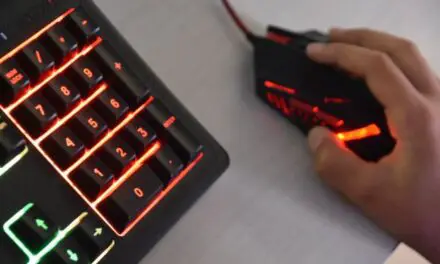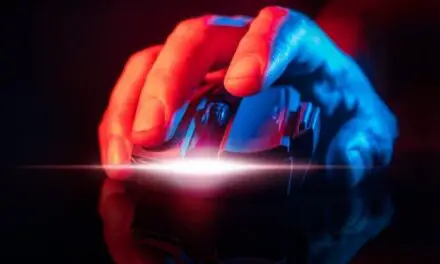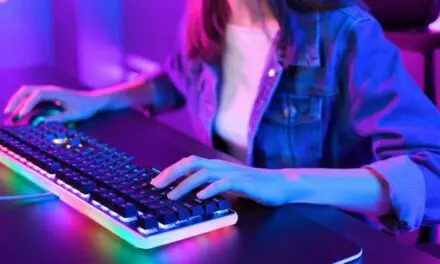You would think that if the technological powers that be could cram an entire gaming system into a small handheld device or even a console, they could do something similar when it comes to all-in-one computers.
However, all-in-ones are marketed at beginner computer users, providing a space-saving, plug-and-play solution for anyone who wants to do some basic computing with minimal fuss.
So does that rule out an all-in-one desktop PC as a viable option for gaming?
Table of Contents
Are All-In-One PCs Good For Gaming?

All-in-one computers are not very good for gaming because their design doesn’t deal with heat very well, they are built with less powerful components than towers and they are very difficult to upgrade and repair.
Even the most powerful all-in-ones – like the Lenovo Yoga AIO 7 – that can offer a decent frame rate for most AAA games at 1080p resolution, is not recommended as a gaming PC for the following reasons.
- It’s difficult to deal with the heat when all those components are crammed in behind the display.
- All-in-ones usually use less powerful laptop components
- All-in-one computers are more difficult to repair
- You’re stuck with the screen it comes with
- Unlike true gaming PCs, they’re difficult to upgrade, which is an essential component
Why Most All-In-One PCs Suck At Gaming
Mostly, all-in-one PCs simply aren’t designed for gaming. Gamers, after all, are not the only ones that purchase PCs. In fact, a massive slice of the computer marketing and sales pie is just regular, everyday computers. The all-in-one PC just happens to be in the middle of growing demand.
That’s mostly because they seem like a simplification for customers and also because of the success of Apple’s iMac.
Gaming on a regular all-in-one computer would probably get you around 60 FPS on Fortnite with lots of tearing and stuttering.
All-In-One Computers Are Usually OK At Everything But Not Great At Specialized Tasks, Like Gaming
All-in-one PCs are your basic, ‘jack of all trades, master of none’ computers. They’re mostly designed for those who aren’t interested in gaming, at least not hardcore gaming, and use their all-in-one PCs for work-related activities, web browsing, or as family computers.
They are Very Difficult to Upgrade
They’re difficult to repair for a couple of reasons. Firstly, most all-in-one PCs utilize a lot of proprietary hardware because it helps them cram everything into a small package.
That means universal replacement parts are off the table, so the necessary component is difficult to get ahold of and ridiculously expensive.
They Become Outdated Quite Quickly
Its often said that as soon as a PC comes off of the assembly line, it’s already obsolete. Well, it’s even more so with all-in-one PCs. They are often manufactured with less capable, older parts that don’t generate nearly as much heat, in an effort to push it all into a small package.
That means that your all-in-one PC was probably obsolete even before it came off the assembly line.
For your basic needs, an all-in-one PC is probably okay, so long as you realize that it is pretty much outdated, even as you are pulling it out of the box.
The fact that they are so difficult to upgrade also ensures they become outdated faster than traditional desktops or gaming towers.
All-In-One Computers Don’t Deal With Heat Very Well
If you packed in a more advanced graphics card and CPU, you would have to start worrying about heat rather quickly.
While an all-in-one PC is probably a little better off than a laptop, because of its open back that doesn’t sit on a desk, they just don’t handle that excess heat very well.
The kind of cooling hardware that goes into a gaming PC is not compatible with an all-in-one PC. It would make a desktop, all-in-one computer look like a giant balloon sitting on a desk.
They Are Difficult To Repair
When you cram everything into a small package, there are going to be some pros and cons too. Sure, it will save you some space on your desk, however, if anything ever goes wrong with it, it’s really difficult to repair.
- The entire monitor and casing have to come off, even for a minor repair
- The screen might be absolutely fine but if one thing is permanently broken, the whole thing is permanently broken
- Motherboards in all-in-one PCs lack alternatives, so you have to replace them with another motherboard of the same type while disassembling the entire PC
That’s one of the more obvious things that you should consider when purchasing an all-in-one PC. If it’s all in one unit, the whole unit has to be turned over and disassembled before repairing even the most minor parts.
All-In-Ones Don’t Usually Come With Great Screens For Gaming
All-in-one PCs usually come with a pretty standard screen. It looks fine if you are freelance writing, browsing the web, or just using your PC for everyday use. However, for gaming purposes, the screens for all-in-one PCs are decidedly lackluster.
They’re usually 1080p HD screens, which is HD, but nowhere near the level of 4k OLED monitors out there.
So not only are you stuck playing something like Roblox, because that’s all the PC will handle, but it also looks like a screen from ten years ago.
Many all-in-one PCs offer touchscreen features as well but the screens haven’t advanced all that much.
Of course, if the screen goes out in your all-in-one, the entire computer has to be replaced, since you can’t do anything without a screen and it doesn’t matter if all of the other parts are perfectly fine.
Related Article: Top 23 Reasons Why You Should Buy A Gaming PC Instead Of A Console
Pound For Pound, All-In-One PCs Are Generally More Expensive
You would think that since all-in-one PCs have a lot of underpowered going into them, they would be cheaper than the alternative.
After all, if you go with a standard PC, you’re buying everything separately, along with what will probably be a much better monitor.
However, that’s not the case, at least not generally.
That’s usually because all-in-one PCs come with almost entirely proprietary hardware. Proprietary hardware is more expensive than the more universal components used in standard PCs.
It’s pretty counterintuitive when you take a step back and think about it. The only premium that you are paying is saving a little bit of space on your desk. And it’s not as if most people even place their towers on their desks so that’s a difficult one to accept as well.
Some people may place their towers on the desks but those who want to save space are going to place their towers on a small, elevated platform beneath the desk and the monitor, keyboard, and mouse are the only things sitting on the desk.
But although it’s not the norm, there are one or two all-in-one desktops that can hold their own when gaming.
Some All-In-One PCs Are Capable Gaming Computers
With all of the negative appeals for staying well away from all-in-one PCs, there are some all-in-ones that are more than capable when it comes to gaming.
Of course, it’s really nice to consider a gaming platform in an all-in-one housing, but some of the negatives listed above don’t go away.
But, if you are really intrigued by the idea of an all-in-one PC, there is a place in the market for a few, reputable gaming PCs.
- Yoga AIO 7: Just looking at the Yoga, it doesn’t scream “PC Gaming” in the least. In fact, it looks rather like a really nice, streamlined all-in-one PC. In reality, it comes with an AMD Radeon RX 6600M or an AMD Ryzen 7 5000 series. It also includes a 4k resolution screen, a Solid State Drive, and 16GB of RAM
- HP ENVY 32 All-in-One: Another stand-out that looks like it belongs in an office is the HP Envy 32 All-In-One. This Intel Core i7 comes with an NVIDIA GeForce GTX 1650, along with an SSD, 16GBs of RAM, and it will run you about the cost of a mid-range iMac.
Can You Connect A Game Console To An All-In-One PC?
That depends on the ports on the back, underside, or side of your all-in-one PC. Most all-in-one PCs have an output HDMI port only, which means that game consoles won’t be able to connect with them since the HDMI port on a game console is output, the one on the PC has to be an input.
Oftentimes, especially on HP all-in-ones, the HDMI port isn’t labeled. However, that usually means that it’s an output only for connecting a second monitor. This is definitely true if it’s the lone HDMI port on the PC.
It’s worth a check, however. It’s not going to hurt anything to plug your console into your all-in-one HDMI port and see if it works.
All Things Considered
All-in-one PCs are a bit of a gamble, even if you are only buying one for straightforward work activities that aren’t too onerous or just as a family computer. As far as gaming is concerned, you will have to go with a very specific all-in-one.
Regardless of why you purchase an all-in-one, you should strongly consider the above-listed negatives, as they can get pretty expensive.



